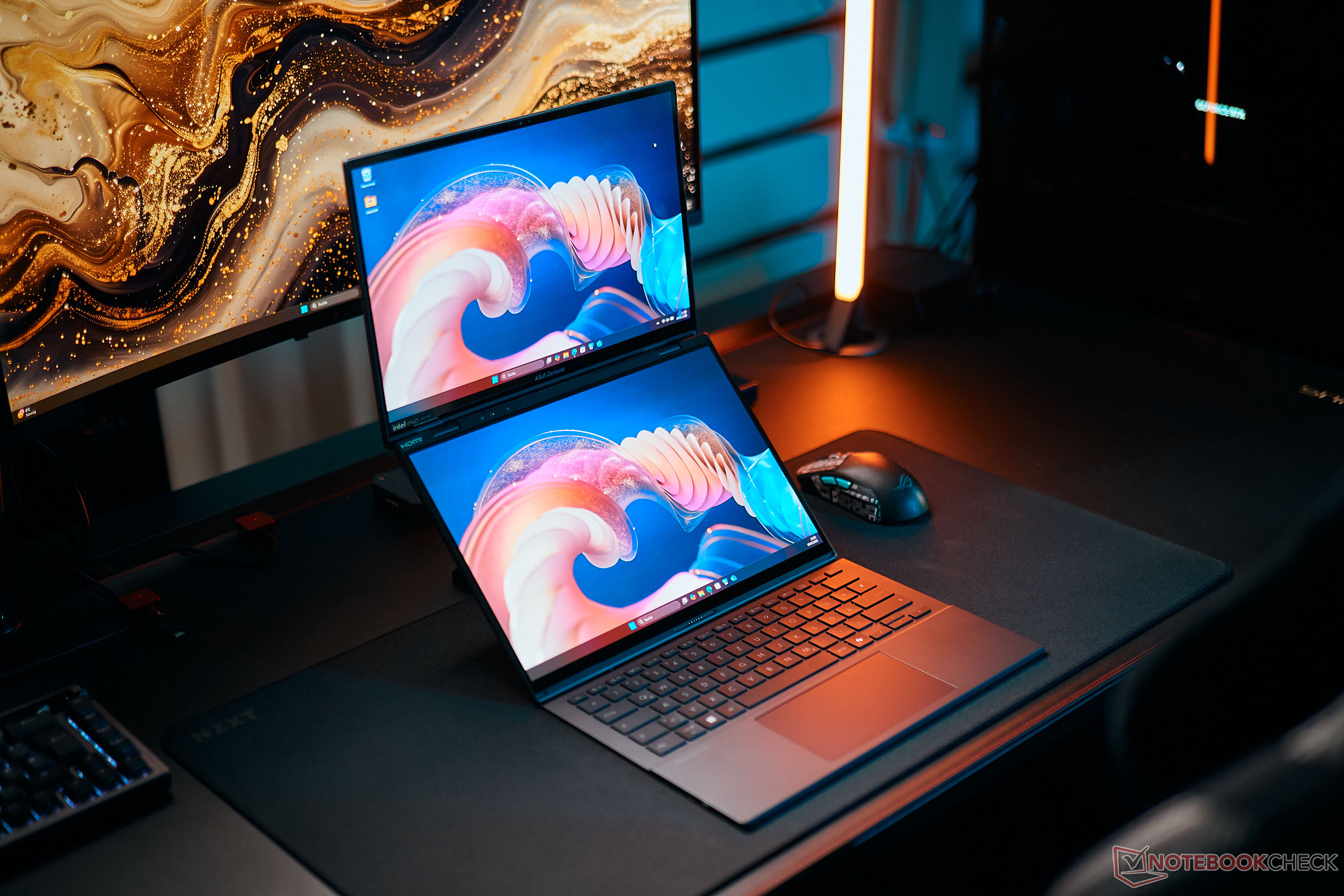
Asus Zenbook Duo OLED review - The multi-screen convertible now with Intel Arrow Lake
Multitasking monster.
The Zenbook Duo is one of the first devices to be equipped with the new Arrow Lake mobile processors from Intel and it's still a highly interesting device thanks to its multi-screen concept. Two 14-inch OLEDs with a FHD resolution are installed in our test device, which helps its battery life in particular.Andreas Osthoff, 👁 Andreas Osthoff (translated by Daisy Dickson) Published 🇩🇪 🇫🇷 ...
Verdict - The Zenbook Duo delivers around 20 % more CPU/GPU performance thanks to Arrow Lake
In 2025, the Zenbook Duo continues to be an extremely exciting convertible thanks to its two OLED screens. Since both screens offer the same features, productive work is no problem and windows can be moved without any scaling issues. Thanks to its built-in kickstand and great detachable keyboard, there are lots of ways to use the Zenbook Duo. The disadvantage of its overall concept is its rather high weight and case thickness of just under 2 cm. In addition, its maintenance options are very limited, as you have to take apart half the device to access the M.2 2280 SSD. Asus has also changed the distribution of its ports slightly—there is now a USB-C port on both sides, which is very handy.
The Zenbook Duo is one of the first devices to use the new Arrow Lake H mobile processors from Intel. These are the direct successors to the Meteor Lake generation and the performance of both the processor and the graphics card has been increased by more than 20%. However, its power limits remain low—especially under continuous load—and the laptop can't fully make use of the Core Ultra 9 285H's performance potential. Unlike the efficient Lunar Lake processors, the Arrow Lake chips use a weaker NPU, which is why the official Copilot+ certification is missing on this device. Even so, functions such as the webcam's Studio Effects or live subtitles are still available, meaning this doesn't make a huge impact on end users.
As with last year's model, you have a choice between two different OLED versions. The 2.8K panel at 120 Hz is reserved for the most expensive version costing around $2,600, while our test device, which can be had for approximately $2,170, is equipped with the 1200p model at 60 Hz. The lower frequency is the most noticeable aspect but subjectively, the screen's picture still looks very good, and both screen models' specifications are comparable apart from their resolution and frequency. The laptop's power consumption and, as a result, its battery life, benefit from the 1200p OLEDs, which should definitely be taken into account for a mobile device.
The Asus Zenbook Duo is still pretty much unrivaled because no other current device on the market can be used in such a versatile way without having to make any real compromises. Lenovo pursues a similar concept with its Yoga Book but in that case, its wireless keyboard has to be transported externally and typing doesn't feel as comfortable—plus, its overall performance is simply significantly lower.
Pros
Cons
Price and availability
The new Zenbook Duo OLED will likely be available to buy at the end of February.
Possible alternatives compared
Image | Model / Review | Price | Weight | Height | Display |
|---|---|---|---|---|---|
| Asus ZenBook Duo OLED UX8406CA Intel Core Ultra 9 285H ⎘ Intel Arc Graphics 140T ⎘ 32 GB Memory, 1024 GB SSD | Amazon: $1,692.99 List Price: 2099€ | 1.8 kg | 19.9 mm | 14.00" 1920x1200 162 PPI OLED | |
| Asus Zenbook Duo OLED UX8406MA Intel Core Ultra 9 185H ⎘ Intel Arc 8-Core iGPU ⎘ 32 GB Memory, 2048 GB SSD | Amazon: $1,606.26 List Price: 2499€ | 1.7 kg | 19.9 mm | 14.00" 2880x1800 243 PPI OLED | |
| Lenovo Yoga Book 9 13IMU9 Intel Core Ultra 7 155U ⎘ Intel Graphics 4-Core iGPU (Arrow Lake) ⎘ 16 GB Memory | List Price: 2000 USD | 1.4 kg | 15.95 mm | 13.30" 2880x1800 255 PPI OLED | |
| Samsung Galaxy Book5 Pro 360 Intel Core Ultra 5 226V ⎘ Intel Arc Graphics 130V ⎘ 16 GB Memory, 512 GB SSD | Amazon: $1,299.99 List Price: 1799€ | 1.7 kg | 12.8 mm | 16.00" 2880x1800 212 PPI OLED | |
| Lenovo Yoga 9 2-in-1 14IMH9 Intel Core Ultra 7 155H ⎘ Intel Arc 8-Core iGPU ⎘ 16 GB Memory, 1024 GB SSD | List Price: 1550 USD | 1.3 kg | 15.9 mm | 14.00" 2880x1800 243 PPI OLED | |
| HP Spectre x360 14-eu0078ng Intel Core Ultra 7 155H ⎘ Intel Arc 8-Core iGPU ⎘ 32 GB Memory, 2048 GB SSD | List Price: 1899€ | 1.5 kg | 16.9 mm | 14.00" 2880x1800 243 PPI OLED |
Last year, Asus launched its Zenbook Duo, an interesting convertible that was very versatile and featured two 14-inch OLED panels and a detachable Bluetooth keyboard. Above all, the two identical panels proved to be a great advantage during use. At that time, the Meteor Lake processor Intel Core Ultra 9 185H was installed and now, the 2025 version of the Zenbook Duo is one of the first devices to be equipped with the brand new Arrow Lake mobile processors from Intel. In our test device (which has an MRSP of around $2,170), the new Core Ultra 9 285H works in conjunction with 32 GB RAM and a 1-TB SSD. Unlike last year's test device, two Full HD OLEDs at 60 Hz are now installed, which is why its picture quality suffers somewhat but its battery life is better. The 3K OLEDs at 120 Hz are still available in the variant costing approximately $2,600 (32 GB RAM, 2 TB SSD).
Specifications
Case & connectivity
In general, the design of the new Zenbook Duo doesn't differ from its predecessor. Visually, we can see lots of similarities to the regular Zenbooks, including its large ProArt logo on the screen lid. The build quality and stability of the case (magnesium alloy) are very good. In addition to the regular screen, the Zenbook Duo features another OLED touchscreen on the top of the base unit. Together with its detachable keyboard, this gives you a convertible with a wide range of possible uses. In order to prop up the Zenbook Duo, there is a built-in kickstand on the bottom, which generally works well. However, the solution still isn't ideal if you want to use the two screens in so-called desktop mode (like an open book), as the main screen then folds back slightly. All-in-all, however, the concept still works very well. Still, with a thickness of just under 2 cm and a weight of almost 1.8 kg (including the keyboard), it is also significantly heavier and thicker than regular 14-inch convertibles.
Asus has taken our criticism to heart when it comes to the laptop's connections and has now changed their layout, as there is now a USB-C port (Thunderbolt 4) on both sides. In addition, it now uses a modern W-Fi 7 module and its transfer rates were great during our test using our reference router from Asus. Its 1080p webcam does its job and advanced Studio Effects are also supported. Officially, however, the new Arrow Lake devices are not Copilot+ devices, as the NPU is too weak. In addition to Studio Effects, the Zenbook also supports Windows live subtitles, among other things. However, accessing all the components is more difficult due to the second screen. You first have to release two connections via a small flap on the underside before the case can be taken apart further. An M.2 2280 SSD is installed inside, which can theoretically be replaced—but this requires you to remove the antenna cables, connection cables and part of the mainboard.
| Networking | |
| Asus ZenBook Duo OLED UX8406CA | |
| iperf3 transmit AXE11000 | |
| iperf3 receive AXE11000 | |
| Asus Zenbook Duo OLED UX8406MA | |
| iperf3 transmit AXE11000 | |
| iperf3 receive AXE11000 | |
| Lenovo Yoga Book 9 13IMU9 | |
| iperf3 transmit AXE11000 | |
| iperf3 receive AXE11000 | |
| iperf3 transmit AXE11000 6GHz | |
| iperf3 receive AXE11000 6GHz | |
| Samsung Galaxy Book5 Pro 360 | |
| iperf3 transmit AXE11000 | |
| iperf3 receive AXE11000 | |
| Lenovo Yoga 9 2-in-1 14IMH9 | |
| iperf3 transmit AXE11000 | |
| iperf3 receive AXE11000 | |
| iperf3 transmit AXE11000 6GHz | |
| iperf3 receive AXE11000 6GHz | |
| HP Spectre x360 14-eu0078ng | |
| iperf3 transmit AXE11000 | |
| iperf3 receive AXE11000 | |

Sustainability
The Zenbook Duo's case is made from 90% recycled materials and its packaging is 100% recycled. The device also meets various environmental standards such as Energy Star, EPEAT Gold and RoHS. Information on the CO2 footprint created during its production is not provided, and no repair instructions are available.
Input devices
In addition to the two touchscreens, the device of course also supports pen input with the supplied Asus Pen 2.0, which works very well. However, the true highlight in our eyes is the detachable keyboard unit, which is very securely attached to the case via magnets. In addition to the keys having a travel of 1.4 mm and quiet keystrokes, they boast a very high rigidity, leading to a very comfortable typing experience. In this aspect, the Zenbook Duo even has an advantage over some regular laptops. The ClickPad also works very well and gives off nice, muffled clicking noises.
The Bluetooth keyboard has a battery and can be charged via USB-C, but as soon as it is placed on the base unit, it connects to the pogo pins and the keyboard is charged automatically. According to Asus, the battery in the keyboard has a runtime of up to 24 hours. The three-level white backlighting can be activated by a sensor.
Display - Dual OLEDs at 1200p
The Zenbook Duo is equipped with two identical 14-inch OLED panels, which is why working with both screens is possible without any issues (identical picture quality, no scaling problems when moving windows). Last year's test device had two high-resolution OLEDs with a 2.8K resolution and a frequency of 120 Hz, while our current test configuration has two full-HD OLEDs at 60 Hz. Apart from this, the other features are the same. The screens' brightness can be adjusted automatically via a sensor, but the color temperature cannot.
Their picture quality is generally very good and a slight raster effect can only be seen on bright content if you look very closely—but this shouldn't be noticeable during everyday use. We measured a maximum SDR brightness of 362 cd/m² on average and, in combination with the low black level, this results in a high contrast ratio that is typical of OLEDs. In HDR mode (which you have to activate manually), we noted a maximum of 625 cd/m² when depicting small image sections and 601 cd/m² when showing an almost completely white image. The screens' response times are very fast and there is no backlight bleeding, although they do use PWM flickering at a frequency of 480 Hz at brightness levels of 86% and less.
| |||||||||||||||||||||||||
Brightness Distribution: 98 %
Center on Battery: 359 cd/m²
Contrast: ∞:1 (Black: 0 cd/m²)
ΔE ColorChecker Calman: 1.2 | ∀{0.5-29.43 Ø4.78}
ΔE Greyscale Calman: 2.1 | ∀{0.09-98 Ø5}
86.7% AdobeRGB 1998 (Argyll 3D)
99.8% sRGB (Argyll 3D)
98.4% Display P3 (Argyll 3D)
Gamma: 2.24
CCT: 6433 K
| Asus ZenBook Duo OLED UX8406CA ATNA40CT02-0, OLED, 1920x1200, 14", 60 Hz | Asus Zenbook Duo OLED UX8406MA SDC419D, OLED, 2880x1800, 14", 120 Hz | Lenovo Yoga Book 9 13IMU9 SDC ATNA33AA02-0, OLED, 2880x1800, 13.3", 60 Hz | Samsung Galaxy Book5 Pro 360 ATNA60CL09-0, OLED, 2880x1800, 16", 120 Hz | Lenovo Yoga 9 2-in-1 14IMH9 LEN140WQ+, OLED, 2880x1800, 14", 120 Hz | HP Spectre x360 14-eu0078ng SDC4197, OLED, 2880x1800, 14", 120 Hz | |
|---|---|---|---|---|---|---|
| Display | 2% | 4% | 4% | 4% | 1% | |
| Display P3 Coverage (%) | 98.4 | 99.6 1% | 99.7 1% | 99.9 2% | 99.8 1% | 99.8 1% |
| sRGB Coverage (%) | 99.8 | 100 0% | 100 0% | 100 0% | 100 0% | 100 0% |
| AdobeRGB 1998 Coverage (%) | 86.7 | 91.8 6% | 97 12% | 96.6 11% | 97.3 12% | 89.3 3% |
| Response Times | 47% | -40% | -22% | 37% | 47% | |
| Response Time Grey 50% / Grey 80% * (ms) | 1.51 ? | 0.77 ? 49% | 1.88 ? -25% | 0.48 ? 68% | 0.8 ? 47% | 0.77 ? 49% |
| Response Time Black / White * (ms) | 1.36 ? | 0.76 ? 44% | 2.1 ? -54% | 0.64 ? 53% | 1 ? 26% | 0.75 ? 45% |
| PWM Frequency (Hz) | 480 ? | 480 ? | 60 ? | 240 ? | 240.5 ? | 480 |
| PWM Amplitude * (%) | 14 | 40 -186% | ||||
| Screen | -1% | -73% | 16% | -78% | 7% | |
| Brightness middle (cd/m²) | 359 | 381 6% | 362.6 1% | 387 8% | 371.6 4% | 378 5% |
| Brightness (cd/m²) | 362 | 384 6% | 368 2% | 392 8% | 373 3% | 384 6% |
| Brightness Distribution (%) | 98 | 98 0% | 97 -1% | 98 0% | 99 1% | 97 -1% |
| Black Level * (cd/m²) | ||||||
| Colorchecker dE 2000 * | 1.2 | 1.6 -33% | 4.66 -288% | 1 17% | 4.91 -309% | 1.4 -17% |
| Colorchecker dE 2000 max. * | 3.2 | 2 37% | 7.25 -127% | 1.9 41% | 8.33 -160% | 2.2 31% |
| Greyscale dE 2000 * | 2.1 | 2.6 -24% | 2.6 -24% | 1.7 19% | 2.2 -5% | 1.7 19% |
| Gamma | 2.24 98% | 2.2 100% | 2.2 100% | 2.25 98% | 2.25 98% | 2.17 101% |
| CCT | 6433 101% | 6784 96% | 6055 107% | 6325 103% | 6120 106% | 6256 104% |
| Colorchecker dE 2000 calibrated * | 0.56 | 1.59 | ||||
| Total Average (Program / Settings) | 16% /
8% | -36% /
-46% | -1% /
3% | -12% /
-35% | 18% /
13% |
* ... smaller is better
We analyzed the laptop's display using the professional CalMAN software. As usual, Asus provides various profiles and the profile "Native" is active by default, which unfortunately depicts the colors a little oversaturated. The P3 profile is a very accurate profile straight out of the box. There is also an sRGB profile and both color spaces are fully covered. We were unable to improve its display any further using our own calibration.
Display Response Times
| ↔ Response Time Black to White | ||
|---|---|---|
| 1.36 ms ... rise ↗ and fall ↘ combined | ↗ 0.74 ms rise | |
| ↘ 0.62 ms fall | ||
| The screen shows very fast response rates in our tests and should be very well suited for fast-paced gaming. In comparison, all tested devices range from 0.1 (minimum) to 240 (maximum) ms. » 6 % of all devices are better. This means that the measured response time is better than the average of all tested devices (20.3 ms). | ||
| ↔ Response Time 50% Grey to 80% Grey | ||
| 1.51 ms ... rise ↗ and fall ↘ combined | ↗ 0.81 ms rise | |
| ↘ 0.7 ms fall | ||
| The screen shows very fast response rates in our tests and should be very well suited for fast-paced gaming. In comparison, all tested devices range from 0.165 (minimum) to 636 (maximum) ms. » 6 % of all devices are better. This means that the measured response time is better than the average of all tested devices (31.7 ms). | ||
Screen Flickering / PWM (Pulse-Width Modulation)
| Screen flickering / PWM detected | 480 Hz Amplitude: 14 % | ≤ 86 % brightness setting | |
The display backlight flickers at 480 Hz (worst case, e.g., utilizing PWM) Flickering detected at a brightness setting of 86 % and below. There should be no flickering or PWM above this brightness setting. The frequency of 480 Hz is relatively high, so most users sensitive to PWM should not notice any flickering. However, there are reports that some users are still sensitive to PWM at 500 Hz and above, so be aware. In comparison: 53 % of all tested devices do not use PWM to dim the display. If PWM was detected, an average of 8149 (minimum: 5 - maximum: 343500) Hz was measured. | |||
Performance - Arrow Lake-H
The new Zenbook Duo comes exclusively with the new Arrow Lake H processors from Intel (Core Ultra 7 or Core Ultra 9), which are combined with either 16 or 32 GB RAM (LPDDR5x-7467). The RAM is soldered on and cannot be expanded.
Testing conditions
Users can choose from four different energy profiles, which are also linked to the Windows settings. We carried out the following benchmarks and measurements in standard mode. The CPU performance can be increased slightly by using the other two modes, but this also leads to significantly louder fans.
| Energy profile | TDP | CB 2024 Multi | Time Spy Graphics | max. fan noise emissions |
|---|---|---|---|---|
| Whisper | 28 watts | 13,144 points | 3,726 points | 33.2 dB(A) |
| Standard | 60/35/24 watts | 16,632 points | 4,074 points | 39.8 dB(A) |
| Performance | 60/45/35 watts | 17,249 points | 4,103 points | 50.2 dB(A) |
| Full speed | 60/45/35 watts | 18,758 points | 4,105 points | 54.3 dB(A) |
Processor - Core Ultra 9 285H
Our test device is equipped with the new top-of-the-range model of the Arrow Lake H series, namely the Intel Core Ultra 9 285H. It is the successor to the Meteor Lake generation and features a total of 16 CPU cores (6x performance, 8x efficiency, 2x low-power efficiency). Further details on the new mobile processors are available in our analysis article. According to Intel, the Arrow Lake H chips once again operate in the 28-115 watt range, which is why the respective device's power limits and cooling again have a major influence on performance. In the case of the Zenbook Duo, we noted up to 60 watts for a short time, then 35 watts and under longer periods of load, its consumption leveled off at around 24 watts. As a result, the Core Ultra 9 285H's full performance potential can't be taken advantage of.
In direct comparison with the old Core Ultra 9 185H, we measured an advantage of around 20% across all benchmarks, which is a good result. However, its performance dropped quickly, which was particularly noticeable in the CB-R15 loop with short runs. After 25 runs, its multi-core performance plummeted by almost 40%. There is no further reduction in performance in battery mode. Further CPU benchmarks are available here.
Cinebench R15 Multi continuous test
Cinebench R23: Multi Core | Single Core
Cinebench R20: CPU (Multi Core) | CPU (Single Core)
Cinebench R15: CPU Multi 64Bit | CPU Single 64Bit
Blender: v2.79 BMW27 CPU
7-Zip 18.03: 7z b 4 | 7z b 4 -mmt1
Geekbench 6.5: Multi-Core | Single-Core
Geekbench 5.5: Multi-Core | Single-Core
HWBOT x265 Benchmark v2.2: 4k Preset
LibreOffice : 20 Documents To PDF
R Benchmark 2.5: Overall mean
| CPU Performance rating | |
| Average Intel Core Ultra 9 285H | |
| Asus ZenBook Duo OLED UX8406CA | |
| Lenovo ThinkPad T14s Gen 6 21M2S00G00 | |
| Asus Zenbook S 16 UM5606WA-RK052W | |
| Lenovo Yoga 9 2-in-1 14IMH9 | |
| Asus Zenbook Duo OLED UX8406MA | |
| HP Spectre x360 14-eu0078ng | |
| Average of class Convertible | |
| Samsung Galaxy Book5 Pro 360 | |
| Asus Zenbook S 14 UX5406 | |
| Lenovo Yoga Book 9 13IMU9 | |
| Cinebench R23 / Multi Core | |
| Average Intel Core Ultra 9 285H (15070 - 23576, n=8) | |
| Asus ZenBook Duo OLED UX8406CA | |
| Lenovo Yoga 9 2-in-1 14IMH9 | |
| Lenovo ThinkPad T14s Gen 6 21M2S00G00 | |
| Asus Zenbook Duo OLED UX8406MA | |
| Asus Zenbook S 16 UM5606WA-RK052W | |
| Average of class Convertible (2949 - 29063, n=57, last 2 years) | |
| HP Spectre x360 14-eu0078ng | |
| Samsung Galaxy Book5 Pro 360 | |
| Lenovo Yoga Book 9 13IMU9 | |
| Asus Zenbook S 14 UX5406 | |
| Cinebench R23 / Single Core | |
| Asus ZenBook Duo OLED UX8406CA | |
| Average Intel Core Ultra 9 285H (1979 - 2164, n=8) | |
| Lenovo ThinkPad T14s Gen 6 21M2S00G00 | |
| Asus Zenbook S 16 UM5606WA-RK052W | |
| Asus Zenbook S 14 UX5406 | |
| Asus Zenbook Duo OLED UX8406MA | |
| Lenovo Yoga 9 2-in-1 14IMH9 | |
| Samsung Galaxy Book5 Pro 360 | |
| Average of class Convertible (914 - 2163, n=57, last 2 years) | |
| HP Spectre x360 14-eu0078ng | |
| Lenovo Yoga Book 9 13IMU9 | |
| Cinebench R20 / CPU (Multi Core) | |
| Average Intel Core Ultra 9 285H (5861 - 9208, n=8) | |
| Asus ZenBook Duo OLED UX8406CA | |
| Lenovo Yoga 9 2-in-1 14IMH9 | |
| Lenovo ThinkPad T14s Gen 6 21M2S00G00 | |
| Asus Zenbook S 16 UM5606WA-RK052W | |
| Asus Zenbook Duo OLED UX8406MA | |
| Average of class Convertible (1124 - 11357, n=57, last 2 years) | |
| HP Spectre x360 14-eu0078ng | |
| Samsung Galaxy Book5 Pro 360 | |
| Lenovo Yoga Book 9 13IMU9 | |
| Asus Zenbook S 14 UX5406 | |
| Cinebench R20 / CPU (Single Core) | |
| Asus ZenBook Duo OLED UX8406CA | |
| Average Intel Core Ultra 9 285H (761 - 830, n=8) | |
| Lenovo ThinkPad T14s Gen 6 21M2S00G00 | |
| Asus Zenbook S 16 UM5606WA-RK052W | |
| Asus Zenbook Duo OLED UX8406MA | |
| Lenovo Yoga 9 2-in-1 14IMH9 | |
| Samsung Galaxy Book5 Pro 360 | |
| Average of class Convertible (348 - 827, n=57, last 2 years) | |
| Lenovo Yoga Book 9 13IMU9 | |
| HP Spectre x360 14-eu0078ng | |
| Asus Zenbook S 14 UX5406 | |
| Cinebench R15 / CPU Multi 64Bit | |
| Average Intel Core Ultra 9 285H (2280 - 3496, n=8) | |
| Asus ZenBook Duo OLED UX8406CA | |
| Lenovo Yoga 9 2-in-1 14IMH9 | |
| Asus Zenbook Duo OLED UX8406MA | |
| HP Spectre x360 14-eu0078ng | |
| Lenovo ThinkPad T14s Gen 6 21M2S00G00 | |
| Asus Zenbook S 16 UM5606WA-RK052W | |
| Average of class Convertible (478 - 4830, n=60, last 2 years) | |
| Asus Zenbook S 14 UX5406 | |
| Lenovo Yoga Book 9 13IMU9 | |
| Samsung Galaxy Book5 Pro 360 | |
| Cinebench R15 / CPU Single 64Bit | |
| Asus ZenBook Duo OLED UX8406CA | |
| Average Intel Core Ultra 9 285H (288 - 322, n=8) | |
| Asus Zenbook S 16 UM5606WA-RK052W | |
| Lenovo ThinkPad T14s Gen 6 21M2S00G00 | |
| Samsung Galaxy Book5 Pro 360 | |
| Lenovo Yoga 9 2-in-1 14IMH9 | |
| Asus Zenbook Duo OLED UX8406MA | |
| Asus Zenbook S 14 UX5406 | |
| Average of class Convertible (149.8 - 317, n=57, last 2 years) | |
| HP Spectre x360 14-eu0078ng | |
| Lenovo Yoga Book 9 13IMU9 | |
| Blender / v2.79 BMW27 CPU | |
| Asus Zenbook S 14 UX5406 | |
| Lenovo Yoga Book 9 13IMU9 | |
| Samsung Galaxy Book5 Pro 360 | |
| Average of class Convertible (107 - 1051, n=56, last 2 years) | |
| HP Spectre x360 14-eu0078ng | |
| Asus Zenbook Duo OLED UX8406MA | |
| Asus Zenbook S 16 UM5606WA-RK052W | |
| Lenovo ThinkPad T14s Gen 6 21M2S00G00 | |
| Lenovo Yoga 9 2-in-1 14IMH9 | |
| Asus ZenBook Duo OLED UX8406CA | |
| Average Intel Core Ultra 9 285H (151 - 235, n=8) | |
| 7-Zip 18.03 / 7z b 4 | |
| Average Intel Core Ultra 9 285H (50116 - 71959, n=8) | |
| Asus ZenBook Duo OLED UX8406CA | |
| Asus Zenbook Duo OLED UX8406MA | |
| Lenovo ThinkPad T14s Gen 6 21M2S00G00 | |
| Lenovo Yoga 9 2-in-1 14IMH9 | |
| Asus Zenbook S 16 UM5606WA-RK052W | |
| HP Spectre x360 14-eu0078ng | |
| Average of class Convertible (12977 - 121368, n=57, last 2 years) | |
| Lenovo Yoga Book 9 13IMU9 | |
| Samsung Galaxy Book5 Pro 360 | |
| Asus Zenbook S 14 UX5406 | |
| 7-Zip 18.03 / 7z b 4 -mmt1 | |
| Asus ZenBook Duo OLED UX8406CA | |
| Average Intel Core Ultra 9 285H (5403 - 6419, n=8) | |
| Asus Zenbook S 16 UM5606WA-RK052W | |
| Asus Zenbook Duo OLED UX8406MA | |
| Asus Zenbook S 14 UX5406 | |
| Lenovo Yoga 9 2-in-1 14IMH9 | |
| Lenovo ThinkPad T14s Gen 6 21M2S00G00 | |
| HP Spectre x360 14-eu0078ng | |
| Samsung Galaxy Book5 Pro 360 | |
| Average of class Convertible (3672 - 6540, n=57, last 2 years) | |
| Lenovo Yoga Book 9 13IMU9 | |
| Geekbench 6.5 / Multi-Core | |
| Average Intel Core Ultra 9 285H (15330 - 17992, n=11) | |
| Asus ZenBook Duo OLED UX8406CA | |
| Asus Zenbook Duo OLED UX8406MA | |
| Lenovo Yoga 9 2-in-1 14IMH9 | |
| Asus Zenbook S 16 UM5606WA-RK052W | |
| Lenovo ThinkPad T14s Gen 6 21M2S00G00 | |
| HP Spectre x360 14-eu0078ng | |
| Asus Zenbook S 14 UX5406 | |
| Average of class Convertible (2291 - 21269, n=58, last 2 years) | |
| Samsung Galaxy Book5 Pro 360 | |
| Lenovo Yoga Book 9 13IMU9 | |
| Geekbench 6.5 / Single-Core | |
| Average Intel Core Ultra 9 285H (2665 - 3110, n=11) | |
| Asus ZenBook Duo OLED UX8406CA | |
| Asus Zenbook S 16 UM5606WA-RK052W | |
| Lenovo ThinkPad T14s Gen 6 21M2S00G00 | |
| Asus Zenbook S 14 UX5406 | |
| Samsung Galaxy Book5 Pro 360 | |
| Asus Zenbook Duo OLED UX8406MA | |
| Lenovo Yoga 9 2-in-1 14IMH9 | |
| Average of class Convertible (1003 - 2978, n=59, last 2 years) | |
| HP Spectre x360 14-eu0078ng | |
| Lenovo Yoga Book 9 13IMU9 | |
| Geekbench 5.5 / Multi-Core | |
| Average Intel Core Ultra 9 285H (13140 - 17487, n=9) | |
| Asus ZenBook Duo OLED UX8406CA | |
| Lenovo Yoga 9 2-in-1 14IMH9 | |
| HP Spectre x360 14-eu0078ng | |
| Lenovo ThinkPad T14s Gen 6 21M2S00G00 | |
| Asus Zenbook Duo OLED UX8406MA | |
| Average of class Convertible (2188 - 22023, n=56, last 2 years) | |
| Asus Zenbook S 16 UM5606WA-RK052W | |
| Asus Zenbook S 14 UX5406 | |
| Samsung Galaxy Book5 Pro 360 | |
| Lenovo Yoga Book 9 13IMU9 | |
| Geekbench 5.5 / Single-Core | |
| Average Intel Core Ultra 9 285H (1911 - 2256, n=9) | |
| Asus Zenbook S 16 UM5606WA-RK052W | |
| Lenovo ThinkPad T14s Gen 6 21M2S00G00 | |
| Asus ZenBook Duo OLED UX8406CA | |
| Asus Zenbook S 14 UX5406 | |
| Samsung Galaxy Book5 Pro 360 | |
| Asus Zenbook Duo OLED UX8406MA | |
| HP Spectre x360 14-eu0078ng | |
| Average of class Convertible (806 - 2275, n=56, last 2 years) | |
| Lenovo Yoga 9 2-in-1 14IMH9 | |
| Lenovo Yoga Book 9 13IMU9 | |
| HWBOT x265 Benchmark v2.2 / 4k Preset | |
| Average Intel Core Ultra 9 285H (17.9 - 27.2, n=8) | |
| Asus ZenBook Duo OLED UX8406CA | |
| Asus Zenbook S 16 UM5606WA-RK052W | |
| Lenovo ThinkPad T14s Gen 6 21M2S00G00 | |
| Asus Zenbook Duo OLED UX8406MA | |
| Lenovo Yoga 9 2-in-1 14IMH9 | |
| Average of class Convertible (3.43 - 36.2, n=57, last 2 years) | |
| Samsung Galaxy Book5 Pro 360 | |
| Lenovo Yoga Book 9 13IMU9 | |
| HP Spectre x360 14-eu0078ng | |
| Asus Zenbook S 14 UX5406 | |
| LibreOffice / 20 Documents To PDF | |
| Asus Zenbook S 14 UX5406 | |
| Asus Zenbook S 16 UM5606WA-RK052W | |
| Lenovo ThinkPad T14s Gen 6 21M2S00G00 | |
| Asus ZenBook Duo OLED UX8406CA | |
| Average of class Convertible (42.5 - 84.3, n=56, last 2 years) | |
| Average Intel Core Ultra 9 285H (39.7 - 54.3, n=8) | |
| Samsung Galaxy Book5 Pro 360 | |
| Asus Zenbook Duo OLED UX8406MA | |
| Lenovo Yoga 9 2-in-1 14IMH9 | |
| Lenovo Yoga Book 9 13IMU9 | |
| HP Spectre x360 14-eu0078ng | |
| R Benchmark 2.5 / Overall mean | |
| Lenovo Yoga Book 9 13IMU9 | |
| Average of class Convertible (0.3985 - 0.84, n=56, last 2 years) | |
| Samsung Galaxy Book5 Pro 360 | |
| HP Spectre x360 14-eu0078ng | |
| Lenovo Yoga 9 2-in-1 14IMH9 | |
| Asus Zenbook Duo OLED UX8406MA | |
| Asus Zenbook S 14 UX5406 | |
| Lenovo ThinkPad T14s Gen 6 21M2S00G00 | |
| Average Intel Core Ultra 9 285H (0.4079 - 0.4794, n=8) | |
| Asus Zenbook S 16 UM5606WA-RK052W | |
| Asus ZenBook Duo OLED UX8406CA | |
* ... smaller is better
AIDA64: FP32 Ray-Trace | FPU Julia | CPU SHA3 | CPU Queen | FPU SinJulia | FPU Mandel | CPU AES | CPU ZLib | FP64 Ray-Trace | CPU PhotoWorxx
| Performance rating | |
| Average Intel Core Ultra 9 285H | |
| Asus ZenBook Duo OLED UX8406CA | |
| Lenovo Yoga 9 2-in-1 14IMH9 | |
| Average of class Convertible | |
| HP Spectre x360 14-eu0078ng | |
| Asus Zenbook Duo OLED UX8406MA | |
| Samsung Galaxy Book5 Pro 360 | |
| Lenovo Yoga Book 9 13IMU9 | |
| AIDA64 / FP32 Ray-Trace | |
| Average Intel Core Ultra 9 285H (15160 - 24612, n=8) | |
| Asus ZenBook Duo OLED UX8406CA | |
| Average of class Convertible (1480 - 64158, n=56, last 2 years) | |
| Samsung Galaxy Book5 Pro 360 | |
| Lenovo Yoga 9 2-in-1 14IMH9 | |
| Asus Zenbook Duo OLED UX8406MA | |
| HP Spectre x360 14-eu0078ng | |
| Lenovo Yoga Book 9 13IMU9 | |
| AIDA64 / FPU Julia | |
| Average Intel Core Ultra 9 285H (54365 - 129641, n=8) | |
| Asus ZenBook Duo OLED UX8406CA | |
| Samsung Galaxy Book5 Pro 360 | |
| Average of class Convertible (11392 - 183760, n=56, last 2 years) | |
| Lenovo Yoga 9 2-in-1 14IMH9 | |
| Asus Zenbook Duo OLED UX8406MA | |
| HP Spectre x360 14-eu0078ng | |
| Lenovo Yoga Book 9 13IMU9 | |
| AIDA64 / CPU SHA3 | |
| Average Intel Core Ultra 9 285H (3695 - 5879, n=8) | |
| Asus ZenBook Duo OLED UX8406CA | |
| Average of class Convertible (797 - 8151, n=56, last 2 years) | |
| Samsung Galaxy Book5 Pro 360 | |
| Lenovo Yoga 9 2-in-1 14IMH9 | |
| Asus Zenbook Duo OLED UX8406MA | |
| Lenovo Yoga Book 9 13IMU9 | |
| HP Spectre x360 14-eu0078ng | |
| AIDA64 / CPU Queen | |
| HP Spectre x360 14-eu0078ng | |
| Lenovo Yoga 9 2-in-1 14IMH9 | |
| Asus Zenbook Duo OLED UX8406MA | |
| Average Intel Core Ultra 9 285H (58606 - 67157, n=8) | |
| Average of class Convertible (14686 - 145339, n=56, last 2 years) | |
| Asus ZenBook Duo OLED UX8406CA | |
| Samsung Galaxy Book5 Pro 360 | |
| Lenovo Yoga Book 9 13IMU9 | |
| AIDA64 / FPU SinJulia | |
| Lenovo Yoga 9 2-in-1 14IMH9 | |
| Average Intel Core Ultra 9 285H (6921 - 9378, n=8) | |
| HP Spectre x360 14-eu0078ng | |
| Asus ZenBook Duo OLED UX8406CA | |
| Asus Zenbook Duo OLED UX8406MA | |
| Average of class Convertible (1120 - 29155, n=56, last 2 years) | |
| Lenovo Yoga Book 9 13IMU9 | |
| Samsung Galaxy Book5 Pro 360 | |
| AIDA64 / FPU Mandel | |
| Average Intel Core Ultra 9 285H (40946 - 64632, n=8) | |
| Asus ZenBook Duo OLED UX8406CA | |
| Samsung Galaxy Book5 Pro 360 | |
| Average of class Convertible (4929 - 97193, n=56, last 2 years) | |
| Lenovo Yoga 9 2-in-1 14IMH9 | |
| Asus Zenbook Duo OLED UX8406MA | |
| HP Spectre x360 14-eu0078ng | |
| Lenovo Yoga Book 9 13IMU9 | |
| AIDA64 / CPU AES | |
| Average Intel Core Ultra 9 285H (58110 - 117613, n=8) | |
| Asus ZenBook Duo OLED UX8406CA | |
| Lenovo Yoga 9 2-in-1 14IMH9 | |
| Asus Zenbook Duo OLED UX8406MA | |
| HP Spectre x360 14-eu0078ng | |
| Average of class Convertible (15752 - 139734, n=56, last 2 years) | |
| Lenovo Yoga Book 9 13IMU9 | |
| Samsung Galaxy Book5 Pro 360 | |
| AIDA64 / CPU ZLib | |
| Average Intel Core Ultra 9 285H (574 - 1366, n=8) | |
| Asus ZenBook Duo OLED UX8406CA | |
| Lenovo Yoga 9 2-in-1 14IMH9 | |
| Average of class Convertible (218 - 2001, n=56, last 2 years) | |
| Asus Zenbook Duo OLED UX8406MA | |
| HP Spectre x360 14-eu0078ng | |
| Lenovo Yoga Book 9 13IMU9 | |
| Samsung Galaxy Book5 Pro 360 | |
| AIDA64 / FP64 Ray-Trace | |
| Average Intel Core Ultra 9 285H (5509 - 13527, n=8) | |
| Asus ZenBook Duo OLED UX8406CA | |
| Samsung Galaxy Book5 Pro 360 | |
| Average of class Convertible (1169 - 34297, n=56, last 2 years) | |
| Lenovo Yoga 9 2-in-1 14IMH9 | |
| HP Spectre x360 14-eu0078ng | |
| Asus Zenbook Duo OLED UX8406MA | |
| Lenovo Yoga Book 9 13IMU9 | |
| AIDA64 / CPU PhotoWorxx | |
| Asus ZenBook Duo OLED UX8406CA | |
| Average Intel Core Ultra 9 285H (49874 - 65229, n=8) | |
| Asus Zenbook Duo OLED UX8406MA | |
| Samsung Galaxy Book5 Pro 360 | |
| Lenovo Yoga 9 2-in-1 14IMH9 | |
| HP Spectre x360 14-eu0078ng | |
| Lenovo Yoga Book 9 13IMU9 | |
| Average of class Convertible (14193 - 81626, n=56, last 2 years) | |
System performance
There were also improvements in its system benchmarks compared to the predecessor model, but this won't be noticeable during everyday use, as the old Zenbook Duo was already a very responsive device. The system also copes very well with multi-screen operation and there were no stability problems during our test.
CrossMark: Overall | Productivity | Creativity | Responsiveness
WebXPRT 3: Overall
WebXPRT 4: Overall
Mozilla Kraken 1.1: Total
| PCMark 10 / Score | |
| Average Intel Core Ultra 9 285H, Intel Arc Graphics 140T (7514 - 7873, n=5) | |
| Lenovo Yoga Pro 7 14ASP G9 | |
| Lenovo Yoga 9 2-in-1 14IMH9 | |
| Asus ZenBook Duo OLED UX8406CA | |
| Lenovo ThinkPad T14s Gen 6 21M2S00G00 | |
| Asus Zenbook S 16 UM5606WA-RK052W | |
| Asus Zenbook S 14 UX5406 | |
| HP Spectre x360 14-eu0078ng | |
| Asus Zenbook Duo OLED UX8406MA | |
| Samsung Galaxy Book5 Pro 360 | |
| Average of class Convertible (3229 - 9125, n=54, last 2 years) | |
| Lenovo Yoga Book 9 13IMU9 | |
| PCMark 10 / Essentials | |
| Lenovo Yoga 9 2-in-1 14IMH9 | |
| Lenovo Yoga Pro 7 14ASP G9 | |
| HP Spectre x360 14-eu0078ng | |
| Lenovo Yoga Book 9 13IMU9 | |
| Asus ZenBook Duo OLED UX8406CA | |
| Average Intel Core Ultra 9 285H, Intel Arc Graphics 140T (10307 - 11171, n=5) | |
| Asus Zenbook Duo OLED UX8406MA | |
| Lenovo ThinkPad T14s Gen 6 21M2S00G00 | |
| Average of class Convertible (7233 - 12222, n=54, last 2 years) | |
| Asus Zenbook S 16 UM5606WA-RK052W | |
| Samsung Galaxy Book5 Pro 360 | |
| Asus Zenbook S 14 UX5406 | |
| PCMark 10 / Productivity | |
| Lenovo Yoga 9 2-in-1 14IMH9 | |
| Lenovo Yoga Pro 7 14ASP G9 | |
| Asus Zenbook S 16 UM5606WA-RK052W | |
| Lenovo ThinkPad T14s Gen 6 21M2S00G00 | |
| Average Intel Core Ultra 9 285H, Intel Arc Graphics 140T (8818 - 10667, n=5) | |
| Asus Zenbook S 14 UX5406 | |
| Samsung Galaxy Book5 Pro 360 | |
| Asus Zenbook Duo OLED UX8406MA | |
| Asus ZenBook Duo OLED UX8406CA | |
| HP Spectre x360 14-eu0078ng | |
| Average of class Convertible (5062 - 10643, n=54, last 2 years) | |
| Lenovo Yoga Book 9 13IMU9 | |
| PCMark 10 / Digital Content Creation | |
| Average Intel Core Ultra 9 285H, Intel Arc Graphics 140T (11705 - 12660, n=5) | |
| Asus ZenBook Duo OLED UX8406CA | |
| Lenovo Yoga Pro 7 14ASP G9 | |
| Lenovo Yoga 9 2-in-1 14IMH9 | |
| Asus Zenbook S 14 UX5406 | |
| Lenovo ThinkPad T14s Gen 6 21M2S00G00 | |
| Samsung Galaxy Book5 Pro 360 | |
| Asus Zenbook S 16 UM5606WA-RK052W | |
| Asus Zenbook Duo OLED UX8406MA | |
| HP Spectre x360 14-eu0078ng | |
| Average of class Convertible (2496 - 16551, n=54, last 2 years) | |
| Lenovo Yoga Book 9 13IMU9 | |
| CrossMark / Overall | |
| Average Intel Core Ultra 9 285H, Intel Arc Graphics 140T (1812 - 2227, n=5) | |
| Asus ZenBook Duo OLED UX8406CA | |
| Asus Zenbook Duo OLED UX8406MA | |
| Lenovo ThinkPad T14s Gen 6 21M2S00G00 | |
| Lenovo Yoga Pro 7 14ASP G9 | |
| Asus Zenbook S 14 UX5406 | |
| Lenovo Yoga 9 2-in-1 14IMH9 | |
| Samsung Galaxy Book5 Pro 360 | |
| Average of class Convertible (524 - 2274, n=57, last 2 years) | |
| Lenovo Yoga Book 9 13IMU9 | |
| HP Spectre x360 14-eu0078ng | |
| CrossMark / Productivity | |
| Average Intel Core Ultra 9 285H, Intel Arc Graphics 140T (1693 - 2170, n=5) | |
| Asus ZenBook Duo OLED UX8406CA | |
| Asus Zenbook Duo OLED UX8406MA | |
| Lenovo ThinkPad T14s Gen 6 21M2S00G00 | |
| Asus Zenbook S 14 UX5406 | |
| Lenovo Yoga 9 2-in-1 14IMH9 | |
| Samsung Galaxy Book5 Pro 360 | |
| Lenovo Yoga Pro 7 14ASP G9 | |
| Average of class Convertible (554 - 1925, n=57, last 2 years) | |
| Lenovo Yoga Book 9 13IMU9 | |
| HP Spectre x360 14-eu0078ng | |
| CrossMark / Creativity | |
| Average Intel Core Ultra 9 285H, Intel Arc Graphics 140T (2125 - 2377, n=5) | |
| Asus ZenBook Duo OLED UX8406CA | |
| Lenovo Yoga Pro 7 14ASP G9 | |
| Asus Zenbook Duo OLED UX8406MA | |
| Asus Zenbook S 14 UX5406 | |
| Lenovo Yoga 9 2-in-1 14IMH9 | |
| Lenovo ThinkPad T14s Gen 6 21M2S00G00 | |
| Samsung Galaxy Book5 Pro 360 | |
| Average of class Convertible (550 - 2949, n=57, last 2 years) | |
| HP Spectre x360 14-eu0078ng | |
| Lenovo Yoga Book 9 13IMU9 | |
| CrossMark / Responsiveness | |
| Average Intel Core Ultra 9 285H, Intel Arc Graphics 140T (1375 - 2191, n=5) | |
| Lenovo ThinkPad T14s Gen 6 21M2S00G00 | |
| Asus ZenBook Duo OLED UX8406CA | |
| Lenovo Yoga 9 2-in-1 14IMH9 | |
| Asus Zenbook Duo OLED UX8406MA | |
| Samsung Galaxy Book5 Pro 360 | |
| Average of class Convertible (381 - 1719, n=57, last 2 years) | |
| Lenovo Yoga Book 9 13IMU9 | |
| Asus Zenbook S 14 UX5406 | |
| Lenovo Yoga Pro 7 14ASP G9 | |
| HP Spectre x360 14-eu0078ng | |
| WebXPRT 3 / Overall | |
| Average Intel Core Ultra 9 285H, Intel Arc Graphics 140T (280 - 358, n=5) | |
| Lenovo Yoga Pro 7 14ASP G9 | |
| Lenovo ThinkPad T14s Gen 6 21M2S00G00 | |
| HP Spectre x360 14-eu0078ng | |
| Asus Zenbook Duo OLED UX8406MA | |
| Average of class Convertible (171 - 426, n=58, last 2 years) | |
| Asus ZenBook Duo OLED UX8406CA | |
| Lenovo Yoga Book 9 13IMU9 | |
| Samsung Galaxy Book5 Pro 360 | |
| Lenovo Yoga 9 2-in-1 14IMH9 | |
| Asus Zenbook S 14 UX5406 | |
| WebXPRT 4 / Overall | |
| Average Intel Core Ultra 9 285H, Intel Arc Graphics 140T (254 - 324, n=5) | |
| Lenovo Yoga Pro 7 14ASP G9 | |
| Samsung Galaxy Book5 Pro 360 | |
| HP Spectre x360 14-eu0078ng | |
| Asus Zenbook Duo OLED UX8406MA | |
| Asus Zenbook S 16 UM5606WA-RK052W | |
| Asus Zenbook S 16 UM5606WA-RK052W | |
| Lenovo ThinkPad T14s Gen 6 21M2S00G00 | |
| Asus ZenBook Duo OLED UX8406CA | |
| Asus Zenbook S 14 UX5406 | |
| Lenovo Yoga Book 9 13IMU9 | |
| Average of class Convertible (91.2 - 317, n=56, last 2 years) | |
| Lenovo Yoga 9 2-in-1 14IMH9 | |
| Mozilla Kraken 1.1 / Total | |
| Asus Zenbook S 14 UX5406 | |
| Lenovo Yoga Book 9 13IMU9 | |
| Average of class Convertible (407 - 1089, n=60, last 2 years) | |
| Lenovo Yoga 9 2-in-1 14IMH9 | |
| HP Spectre x360 14-eu0078ng | |
| Samsung Galaxy Book5 Pro 360 | |
| Asus Zenbook Duo OLED UX8406MA | |
| Asus ZenBook Duo OLED UX8406CA | |
| Asus Zenbook S 16 UM5606WA-RK052W | |
| Asus Zenbook S 16 UM5606WA-RK052W | |
| Lenovo ThinkPad T14s Gen 6 21M2S00G00 | |
| Lenovo Yoga Pro 7 14ASP G9 | |
| Average Intel Core Ultra 9 285H, Intel Arc Graphics 140T (418 - 465, n=5) | |
* ... smaller is better
| PCMark 10 Score | 7514 points | |
Help | ||
| AIDA64 / Memory Copy | |
| Samsung Galaxy Book5 Pro 360 | |
| HP Spectre x360 14-eu0078ng | |
| Average Intel Core Ultra 9 285H (76816 - 109252, n=8) | |
| Lenovo Yoga 9 2-in-1 14IMH9 | |
| Asus Zenbook Duo OLED UX8406MA | |
| Asus ZenBook Duo OLED UX8406CA | |
| Average of class Convertible (23880 - 158525, n=56, last 2 years) | |
| Lenovo Yoga Book 9 13IMU9 | |
| AIDA64 / Memory Read | |
| Lenovo Yoga 9 2-in-1 14IMH9 | |
| HP Spectre x360 14-eu0078ng | |
| Samsung Galaxy Book5 Pro 360 | |
| Asus Zenbook Duo OLED UX8406MA | |
| Average Intel Core Ultra 9 285H (75428 - 85799, n=8) | |
| Asus ZenBook Duo OLED UX8406CA | |
| Average of class Convertible (19931 - 126725, n=56, last 2 years) | |
| Lenovo Yoga Book 9 13IMU9 | |
| AIDA64 / Memory Write | |
| Samsung Galaxy Book5 Pro 360 | |
| Average of class Convertible (17473 - 216896, n=56, last 2 years) | |
| Asus ZenBook Duo OLED UX8406CA | |
| Lenovo Yoga 9 2-in-1 14IMH9 | |
| Asus Zenbook Duo OLED UX8406MA | |
| Average Intel Core Ultra 9 285H (62446 - 82553, n=8) | |
| HP Spectre x360 14-eu0078ng | |
| Lenovo Yoga Book 9 13IMU9 | |
| AIDA64 / Memory Latency | |
| Lenovo Yoga 9 2-in-1 14IMH9 | |
| Asus Zenbook Duo OLED UX8406MA | |
| HP Spectre x360 14-eu0078ng | |
| Lenovo Yoga Book 9 13IMU9 | |
| Asus ZenBook Duo OLED UX8406CA | |
| Average of class Convertible (6.9 - 536, n=55, last 2 years) | |
| Average Intel Core Ultra 9 285H (116 - 136.7, n=8) | |
| Samsung Galaxy Book5 Pro 360 | |
* ... smaller is better
DPC latencies
| DPC Latencies / LatencyMon - interrupt to process latency (max), Web, Youtube, Prime95 | |
| Lenovo Yoga 9 2-in-1 14IMH9 | |
| Lenovo Yoga Book 9 13IMU9 | |
| Samsung Galaxy Book5 Pro 360 | |
| HP Spectre x360 14-eu0078ng | |
| Asus Zenbook Duo OLED UX8406MA | |
| Asus ZenBook Duo OLED UX8406CA | |
* ... smaller is better
Storage device
A 1-TB version of the Western Digital SN5000S is installed in our test device, with 870 GB still available to the user after first starting up the laptop. The PCIe 4.0 SSD's performance was great during our test, remaining stable even under prolonged load. So there are no problems in this area. Further SSD benchmarks are listed in our tech section.
* ... smaller is better
Reading continuous performance: DiskSpd Read Loop, Queue Depth 8
Graphics card
The Core Ultra 9 285H's integrated graphics card is called the Intel Arc Graphics 140T and is an improved version of the old Intel Arc Graphics with 8 Xe cores. It continues to use the Xe cores from the first generation, so technically, there is already a clear difference to the Intel Arc Graphics 140V of the current Lunar Lake models. All other technical details are available in our GPU analysis article.
During the synthetic benchmarks, the new 140T was around 20% ahead of the old Arc Graphics with 8 Xe cores, but the Arc Graphics 140V was practically on par. In the actual gaming benchmarks, however, the Lunar Lake GPU had a clear advantage in some cases. Compared to the old Zenbook Duo, however, it still had an advantage of more than 20%. The Intel iGPUs now also support Frame Generation in selected games, which makes a clear difference and we took a closer look at this in our GPU analysis. Its performance remains stable both in battery mode and under prolonged load.
| 3DMark 11 Performance | 14934 points | |
| 3DMark Fire Strike Score | 9595 points | |
| 3DMark Time Spy Score | 4330 points | |
| 3DMark Steel Nomad Score | 834 points | |
| 3DMark Steel Nomad Light Score | 3620 points | |
Help | ||
| Blender / v3.3 Classroom CPU | |
| Lenovo Yoga Book 9 13IMU9 | |
| Average of class Convertible (163 - 2067, n=58, last 2 years) | |
| HP Spectre x360 14-eu0078ng | |
| Samsung Galaxy Book5 Pro 360 | |
| Asus Zenbook Duo OLED UX8406MA | |
| Lenovo Yoga 9 2-in-1 14IMH9 | |
| Asus ZenBook Duo OLED UX8406CA | |
| Average Intel Arc Graphics 140T (262 - 492, n=16) | |
* ... smaller is better
Cyberpunk 2077 ultra FPS diagram
| low | med. | high | ultra | |
|---|---|---|---|---|
| GTA V (2015) | 172 | 161.1 | 41.7 | 16.8 |
| Dota 2 Reborn (2015) | 105.6 | 83.5 | 80.1 | 69.5 |
| Final Fantasy XV Benchmark (2018) | 80.6 | 46.9 | 29.4 | |
| X-Plane 11.11 (2018) | 56.3 | 44.7 | 38.8 | |
| Far Cry 5 (2018) | 80 | 48 | 45 | 38 |
| Strange Brigade (2018) | 200 | 90.2 | 75.1 | 61.2 |
| Baldur's Gate 3 (2023) | 39.4 | 30.7 | 25.7 | 24.4 |
| Cyberpunk 2077 2.2 Phantom Liberty (2023) | 37.6 | 32.3 | 27.7 | 24.1 |
| F1 24 (2024) | 77.7 | 69.5 | 56.6 | 19.3 |
Emissions & energy
Noise emissions
The two fans' overall noise development is comparable to that of the predecessor model. In standard mode, the cooling is often completely deactivated during simple tasks. Under higher load (e.g. gaming, CPU load or stress test), we measured a maximum of 39.8 dB(A), which is of course clearly audible, but not yet annoying. In whisper mode (which also offers sufficient performance for everyday tasks), the Zenbook Duo remains significantly quieter at a maximum of 33.2 dB(A). The two faster modes (performance & full speed), on the other hand, are unpleasantly loud at over 50 dB(A). There were no other electronic noises coming from our test device during the test phase.
Noise level
| Idle |
| 23.6 / 23.6 / 23.6 dB(A) |
| Load |
| 39.8 / 39.8 dB(A) |
 | ||
30 dB silent 40 dB(A) audible 50 dB(A) loud |
||
min: | ||
| Asus ZenBook Duo OLED UX8406CA Arc 140T, Ultra 9 285H, Western Digital PC SN5000S SDEQNSJ-1T00 | Asus Zenbook Duo OLED UX8406MA Arc 8-Core, Ultra 9 185H, WD PC SN740 SDDPNQE-2T00 | Lenovo Yoga Book 9 13IMU9 Graphics 4-Core iGPU (Arrow Lake), Ultra 7 155U | Samsung Galaxy Book5 Pro 360 Arc 130V, Core Ultra 5 226V, Samsung PM9B1 512GB MZVL4512HBLU | Lenovo Yoga 9 2-in-1 14IMH9 Arc 8-Core, Ultra 7 155H, Samsung PM9C1a MZAL81T0HDLB | HP Spectre x360 14-eu0078ng Arc 8-Core, Ultra 7 155H, Kioxia XG8 KXG80ZNV2T04 | |
|---|---|---|---|---|---|---|
| Noise | -3% | 11% | 3% | -1% | 8% | |
| off / environment * (dB) | 23.6 | 24 -2% | 23.3 1% | 23.6 -0% | 23.2 2% | 23.4 1% |
| Idle Minimum * (dB) | 23.6 | 24 -2% | 23.3 1% | 23.6 -0% | 23.6 -0% | 23.4 1% |
| Idle Average * (dB) | 23.6 | 24 -2% | 23.3 1% | 23.6 -0% | 23.6 -0% | 23.4 1% |
| Idle Maximum * (dB) | 23.6 | 26.7 -13% | 24.6 -4% | 23.6 -0% | 25 -6% | 25.6 -8% |
| Load Average * (dB) | 39.8 | 39.4 1% | 26.2 34% | 29.4 26% | 34.8 13% | 25.6 36% |
| Cyberpunk 2077 ultra * (dB) | 39.8 | 40.6 -2% | ||||
| Load Maximum * (dB) | 39.8 | 39.4 1% | 27.3 31% | 40.6 -2% | 46.2 -16% | 32.6 18% |
| Witcher 3 ultra * (dB) | 39.4 | 27.3 | 37.7 | 30.9 |
* ... smaller is better
Temperature
There are no major changes to its surface temperatures compared to the old model. The case stays very cool in idle mode and during simple tasks. Under load, we noted a hotspot in the upper middle area of the underside, but 47 °C is by no means critical and you can still place it on your thighs without any restrictions. The keyboard remains significantly cooler, although you naturally benefit from the fact that it is a separate component. During the stress test, the processor initially briefly reached 60 watts before leveling off at 35 watts for a few minutes and later at around 24 watts (the old model was ~20 watts).
(+) The maximum temperature on the upper side is 35.3 °C / 96 F, compared to the average of 35.4 °C / 96 F, ranging from 19.6 to 60 °C for the class Convertible.
(-) The bottom heats up to a maximum of 47.2 °C / 117 F, compared to the average of 36.8 °C / 98 F
(+) In idle usage, the average temperature for the upper side is 24.1 °C / 75 F, compared to the device average of 30.3 °C / 87 F.
(+) 3: The average temperature for the upper side is 31.5 °C / 89 F, compared to the average of 30.3 °C / 87 F for the class Convertible.
(+) The palmrests and touchpad are cooler than skin temperature with a maximum of 28.5 °C / 83.3 F and are therefore cool to the touch.
(±) The average temperature of the palmrest area of similar devices was 27.9 °C / 82.2 F (-0.6 °C / -1.1 F).
| Asus ZenBook Duo OLED UX8406CA Intel Core Ultra 9 285H, Intel Arc Graphics 140T | Asus Zenbook Duo OLED UX8406MA Intel Core Ultra 9 185H, Intel Arc 8-Core iGPU | Lenovo Yoga Book 9 13IMU9 Intel Core Ultra 7 155U, Intel Graphics 4-Core iGPU (Arrow Lake) | Samsung Galaxy Book5 Pro 360 Intel Core Ultra 5 226V, Intel Arc Graphics 130V | Lenovo Yoga 9 2-in-1 14IMH9 Intel Core Ultra 7 155H, Intel Arc 8-Core iGPU | HP Spectre x360 14-eu0078ng Intel Core Ultra 7 155H, Intel Arc 8-Core iGPU | |
|---|---|---|---|---|---|---|
| Heat | -8% | -12% | 1% | -17% | 2% | |
| Maximum Upper Side * (°C) | 35.3 | 35.6 -1% | 39.2 -11% | 40.9 -16% | 40 -13% | 39.3 -11% |
| Maximum Bottom * (°C) | 47.2 | 46.6 1% | 41 13% | 45.1 4% | 43 9% | 45 5% |
| Idle Upper Side * (°C) | 24.8 | 27.1 -9% | 32.2 -30% | 23.8 4% | 32 -29% | 23.8 4% |
| Idle Bottom * (°C) | 26.2 | 32.3 -23% | 31.6 -21% | 23.5 10% | 35.2 -34% | 24 8% |
* ... smaller is better
Speakers
The stereo speakers continue to offer very good performance, but the comparison devices all perform similarly well.
Asus ZenBook Duo OLED UX8406CA audio analysis
(+) | speakers can play relatively loud (84.9 dB)
Bass 100 - 315 Hz
(±) | reduced bass - on average 10% lower than median
(±) | linearity of bass is average (10% delta to prev. frequency)
Mids 400 - 2000 Hz
(+) | balanced mids - only 3.2% away from median
(+) | mids are linear (3.2% delta to prev. frequency)
Highs 2 - 16 kHz
(+) | balanced highs - only 2.2% away from median
(+) | highs are linear (3.1% delta to prev. frequency)
Overall 100 - 16.000 Hz
(+) | overall sound is linear (10.2% difference to median)
Compared to same class
» 6% of all tested devices in this class were better, 2% similar, 92% worse
» The best had a delta of 6%, average was 20%, worst was 57%
Compared to all devices tested
» 4% of all tested devices were better, 1% similar, 94% worse
» The best had a delta of 4%, average was 24%, worst was 134%
Lenovo Yoga Book 9 13IMU9 audio analysis
(+) | speakers can play relatively loud (84.1 dB)
Bass 100 - 315 Hz
(±) | reduced bass - on average 8.2% lower than median
(±) | linearity of bass is average (7.5% delta to prev. frequency)
Mids 400 - 2000 Hz
(+) | balanced mids - only 2.3% away from median
(+) | mids are linear (3.4% delta to prev. frequency)
Highs 2 - 16 kHz
(+) | balanced highs - only 1.3% away from median
(+) | highs are linear (2.4% delta to prev. frequency)
Overall 100 - 16.000 Hz
(+) | overall sound is linear (7.4% difference to median)
Compared to same class
» 2% of all tested devices in this class were better, 1% similar, 98% worse
» The best had a delta of 6%, average was 20%, worst was 57%
Compared to all devices tested
» 1% of all tested devices were better, 0% similar, 99% worse
» The best had a delta of 4%, average was 24%, worst was 134%
Samsung Galaxy Book5 Pro 360 audio analysis
(+) | speakers can play relatively loud (82.3 dB)
Bass 100 - 315 Hz
(±) | reduced bass - on average 14.1% lower than median
(±) | linearity of bass is average (8.4% delta to prev. frequency)
Mids 400 - 2000 Hz
(+) | balanced mids - only 3.8% away from median
(+) | mids are linear (3.6% delta to prev. frequency)
Highs 2 - 16 kHz
(+) | balanced highs - only 2.3% away from median
(+) | highs are linear (4.9% delta to prev. frequency)
Overall 100 - 16.000 Hz
(+) | overall sound is linear (11.9% difference to median)
Compared to same class
» 11% of all tested devices in this class were better, 4% similar, 86% worse
» The best had a delta of 6%, average was 20%, worst was 57%
Compared to all devices tested
» 8% of all tested devices were better, 2% similar, 89% worse
» The best had a delta of 4%, average was 24%, worst was 134%
Lenovo Yoga 9 2-in-1 14IMH9 audio analysis
(+) | speakers can play relatively loud (85.5 dB)
Bass 100 - 315 Hz
(±) | reduced bass - on average 9.7% lower than median
(±) | linearity of bass is average (10.7% delta to prev. frequency)
Mids 400 - 2000 Hz
(+) | balanced mids - only 1.5% away from median
(+) | mids are linear (2.6% delta to prev. frequency)
Highs 2 - 16 kHz
(+) | balanced highs - only 2% away from median
(+) | highs are linear (2.2% delta to prev. frequency)
Overall 100 - 16.000 Hz
(+) | overall sound is linear (7% difference to median)
Compared to same class
» 1% of all tested devices in this class were better, 1% similar, 98% worse
» The best had a delta of 6%, average was 20%, worst was 57%
Compared to all devices tested
» 1% of all tested devices were better, 0% similar, 99% worse
» The best had a delta of 4%, average was 24%, worst was 134%
HP Spectre x360 14-eu0078ng audio analysis
(+) | speakers can play relatively loud (84.4 dB)
Bass 100 - 315 Hz
(±) | reduced bass - on average 10.1% lower than median
(±) | linearity of bass is average (10.3% delta to prev. frequency)
Mids 400 - 2000 Hz
(+) | balanced mids - only 3.6% away from median
(+) | mids are linear (3.1% delta to prev. frequency)
Highs 2 - 16 kHz
(+) | balanced highs - only 1.8% away from median
(+) | highs are linear (5% delta to prev. frequency)
Overall 100 - 16.000 Hz
(+) | overall sound is linear (8.9% difference to median)
Compared to same class
» 4% of all tested devices in this class were better, 1% similar, 96% worse
» The best had a delta of 6%, average was 20%, worst was 57%
Compared to all devices tested
» 2% of all tested devices were better, 1% similar, 97% worse
» The best had a delta of 4%, average was 24%, worst was 134%
Power consumption
The consumption measurements show the Full HD OLEDs to have an advantage compared to the 2.8K models that we tested in the predecessor model. Under load, however, the two models don't differ much, which isn't really surprising given their identical power limits. We measured a maximum of 65 watts during the stress test, which quickly leveled off at 54 and then around 45 watts. In principle, the compact 65-watt power supply is therefore sufficient in size. However, its standby consumption of 1.1 watts is slightly too high and also higher than the old model (0.71 watts).
| Off / Standby | |
| Idle | |
| Load |
|
Key:
min: | |
| Asus ZenBook Duo OLED UX8406CA Arc 140T, Ultra 9 285H, Western Digital PC SN5000S SDEQNSJ-1T00 | Asus Zenbook Duo OLED UX8406MA Arc 8-Core, Ultra 9 185H, WD PC SN740 SDDPNQE-2T00 | Lenovo Yoga Book 9 13IMU9 Graphics 4-Core iGPU (Arrow Lake), Ultra 7 155U | Samsung Galaxy Book5 Pro 360 Arc 130V, Core Ultra 5 226V, Samsung PM9B1 512GB MZVL4512HBLU | Lenovo Yoga 9 2-in-1 14IMH9 Arc 8-Core, Ultra 7 155H, Samsung PM9C1a MZAL81T0HDLB | HP Spectre x360 14-eu0078ng Arc 8-Core, Ultra 7 155H, Kioxia XG8 KXG80ZNV2T04 | |
|---|---|---|---|---|---|---|
| Power Consumption | -23% | -37% | 8% | -9% | 28% | |
| Idle Minimum * (Watt) | 4.1 | 6.9 -68% | 7.1 -73% | 5.3 -29% | 4.2 -2% | 3.2 22% |
| Idle Average * (Watt) | 8.2 | 10.2 -24% | 9.1 -11% | 6.7 18% | 7.1 13% | 4.2 49% |
| Idle Maximum * (Watt) | 8.7 | 10.9 -25% | 18.4 -111% | 7.3 16% | 12.9 -48% | 4.9 44% |
| Load Average * (Watt) | 56.7 | 52.8 7% | 51.3 10% | 37.6 34% | 58.9 -4% | 40.5 29% |
| Cyberpunk 2077 ultra * (Watt) | 48.7 | 44.6 8% | ||||
| Cyberpunk 2077 ultra external monitor * (Watt) | 47 | 42.8 9% | ||||
| Load Maximum * (Watt) | 65.1 | 67.1 -3% | 65.5 -1% | 64.1 2% | 66.7 -2% | 68.6 -5% |
| Witcher 3 ultra * (Watt) | 43.2 | 41.5 | 49.5 | 37.9 |
* ... smaller is better
Power consumption Cyberpunk / stress test
Power consumption with external monitor
Runtimes
Nothing has changed about its 75 Wh battery, but the screens' lower resolution/frequency has had a positive effect on the laptop's battery runtimes. During the WLAN test at 150 cd/m² (corresponds to 70% of our test device's maximum SDR brightness) with an active display, its runtime increased from just under 9.5 hours to just over 11 hours. At full brightness, it we noted just under 8.5 hours compared to the predecessor's 7 hours. As expected, its runtime is reduced with two active displays, but 8:17 hours at 150 cd/m² and 6 hours at full brightness are still by no means bad results. In the video test at 150 cd/m² and with one screen, we even recorded almost 17 hours, which is nearly 3.5 hours more than before.
However, its better results are primarily due to the displays and not its new processor. So if you opt for a configuration with the 2.8K OLEDs, you can use the runtimes of our 2024 review as a guide. A full charge takes 110 minutes with the device switched on, with 80% of its capacity being available again after around 65 minutes.
| Asus ZenBook Duo OLED UX8406CA Ultra 9 285H, Arc 140T, 75 Wh | Asus Zenbook Duo OLED UX8406MA Ultra 9 185H, Arc 8-Core, 75 Wh | Lenovo Yoga Book 9 13IMU9 Ultra 7 155U, Graphics 4-Core iGPU (Arrow Lake), 80 Wh | Samsung Galaxy Book5 Pro 360 Core Ultra 5 226V, Arc 130V, 76 Wh | Lenovo Yoga 9 2-in-1 14IMH9 Ultra 7 155H, Arc 8-Core, 75 Wh | HP Spectre x360 14-eu0078ng Ultra 7 155H, Arc 8-Core, 68 Wh | Average of class Convertible | |
|---|---|---|---|---|---|---|---|
| Battery runtime | -17% | -9% | 7% | -10% | -9% | -5% | |
| H.264 (h) | 16.9 | 13.7 -19% | 19.7 17% | 16.7 -1% | 15.2 ? -10% | ||
| WiFi v1.3 (h) | 11.1 | 9.4 -15% | 10.1 -9% | 10.8 -3% | 10 -10% | 9.3 -16% | 11.2 ? 1% |
Notebookcheck total rating
The Zenbook Duo continues to be a very exciting multi-screen convertible. The 1200p OLEDs in our test model don't quite achieve the picture quality of the 2.8K screens in the more expensive configuration, but they reduce its power consumption and thus increase the laptop's battery life. The new Arrow Lake processor offers around 20% more CPU performance than before but overall, the Zenbook Duo's power limits remain quite low (especially under prolonged load) and the full performance potential of the Core Ultra 9 285H cannot be exploited.
Asus ZenBook Duo OLED UX8406CA
- 02/08/2025 v8
Andreas Osthoff
Transparency
The selection of devices to be reviewed is made by our editorial team. The test sample was provided to the author as a loan by the manufacturer or retailer for the purpose of this review. The lender had no influence on this review, nor did the manufacturer receive a copy of this review before publication. There was no obligation to publish this review. As an independent media company, Notebookcheck is not subjected to the authority of manufacturers, retailers or publishers.
This is how Notebookcheck is testing
Every year, Notebookcheck independently reviews hundreds of laptops and smartphones using standardized procedures to ensure that all results are comparable. We have continuously developed our test methods for around 20 years and set industry standards in the process. In our test labs, high-quality measuring equipment is utilized by experienced technicians and editors. These tests involve a multi-stage validation process. Our complex rating system is based on hundreds of well-founded measurements and benchmarks, which maintains objectivity. Further information on our test methods can be found here.










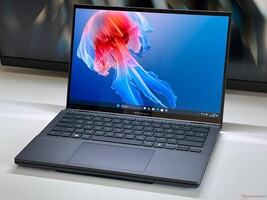
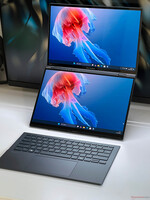
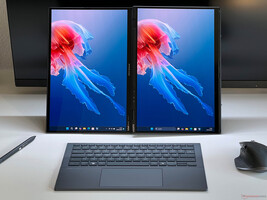
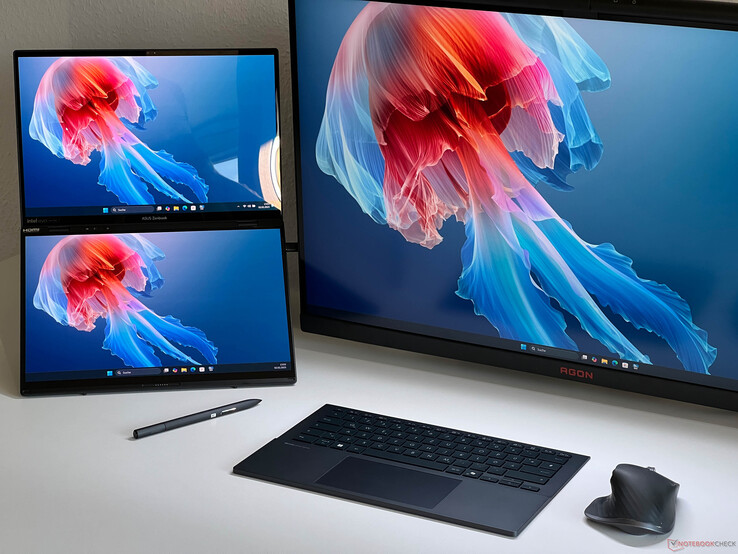












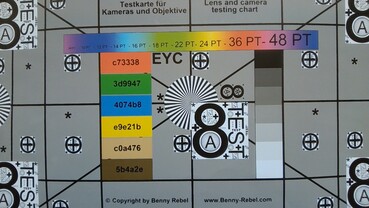

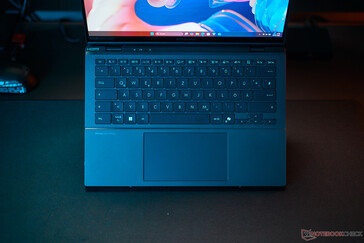
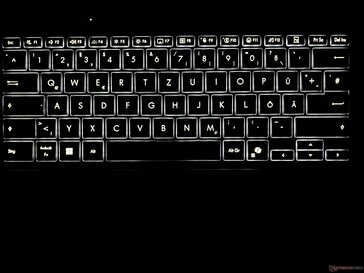
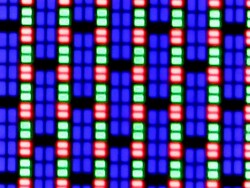
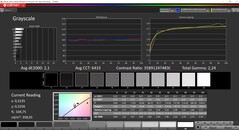
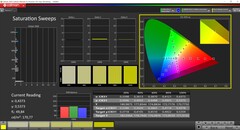
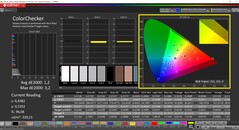
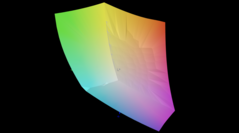
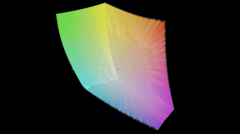
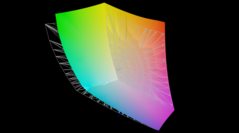
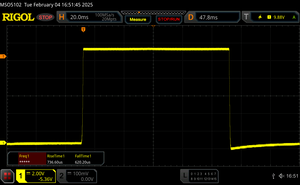
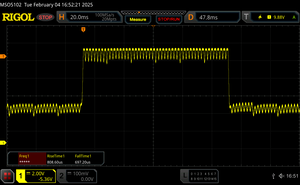
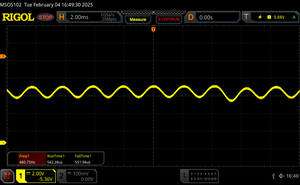

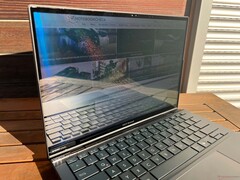
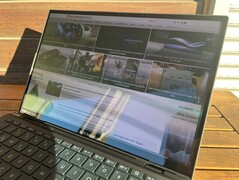
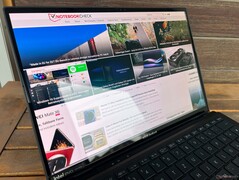
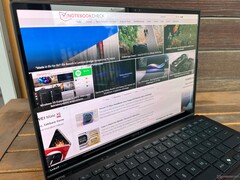
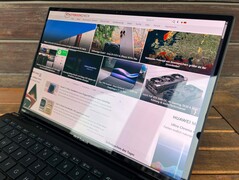

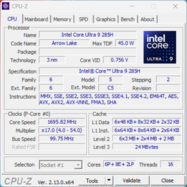
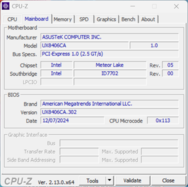
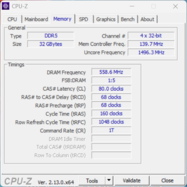
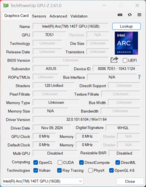

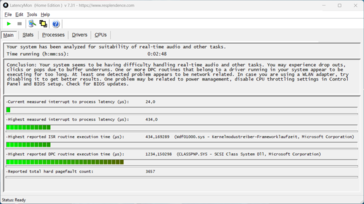
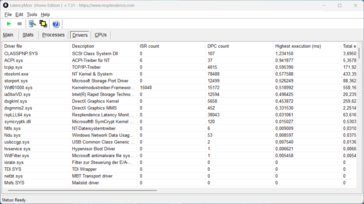

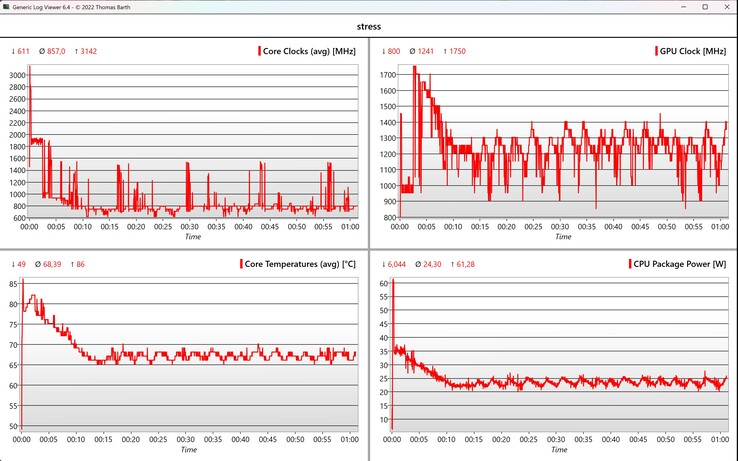
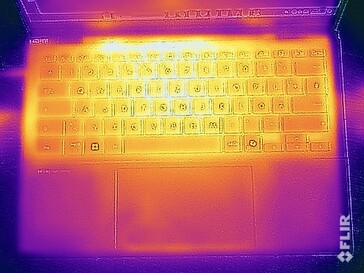
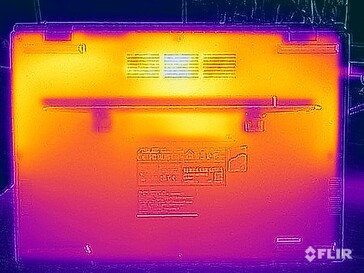
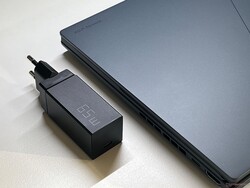
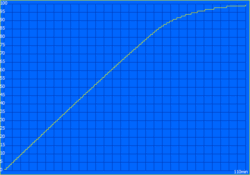
 Total Sustainability Score:
Total Sustainability Score: 








